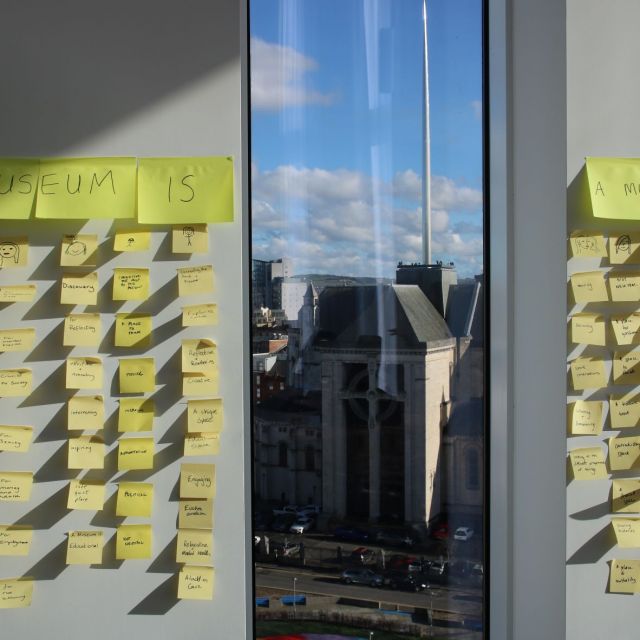Designing In/For/With the Museum Part 5
by Alan Hook. The latest in a series of blogs, this post looks at introducing museums studies students to interactive design techniques.

by Alan Hook. The latest in a series of blogs, this post looks at introducing museums studies students to interactive design techniques.

The open workshop that the project ran with the Museums and stakeholders such as design agencies that have worked closely with the Museum and Heritage sector provided findings that helped the team develop the Digital Museums Report. This report proposes a set of actions and policy interventions to help the Museum and Heritage sector.
One of the recommendations of the report was to establish new approaches to skills development and content production. Building on previous work with Dr Oonagh Murphy, entitled 'This Is Our Playground', which teamed students with museums to think about visitor experience, I collaborated with Prof Elizabeth Crooke to develop a one day workshop to share skills and knowledge with MA students. This skills and knowledge sharing works both ways and it was important to test ideas with the MA students as a new generation of thinkers, makers and gatekeepers for the sector.
Students were asked to produce a short essay before the event which chose one object from the Ulster Museum (to help focus the task and exercise). Students were assessed in their module on the cultural reading of the object or artefact using a particular cultural lens. This helped the students frame the cultural, historical or political importance of the artefact and offer a complex reading.
As part of the workshop we also worked through some core ideas with the students as a complicated icebreaker. We asked students to answer some core questions about what they thought a museum was, and what role it played. This task has been covered in previous posts, but helped us to build some core ideas, share our thoughts openly and give us some core development values as a backstop.
We worked with student on some confidence building, asking them to say a few words into the microphone about why they picked their particular object. While we recorded, and then immediately deleted, the audio files I explained to them how the equipment worked, what I was taking into consideration when I recorded (levels, tone, inflection, projection etc).
I presented a series of core ideas to the students about sound, unpacking technical language and discussing with them core equipment, when we use it, how we use it and why we use it. It was important to work at a number of scales through this workshop to show how (lesser quality but) similar outcomes can be produced at different price points. This type of activity is key when working with the cultural sector who often work within micro-budget constraints and with existing equipment. We discussed audio recorders, microphones, easy ways to produce high quality audio cheaply, and how the core principles work at each level, but money can improve the fidelity and also make the process easier.
We used this workshop to discuss a prototype for a visitor experience that the team has been developing working with the core design principles. The workshop was useful to raise issues, gather feedback from professionals, and discuss the focus and direction of future developments. The prototype is for a web-hosted mobile location based experience which uses augmented reality to rethink the audio tour. A simple, early stage prototype was showcased and discussed.
This prototype shows a small white box which can be locked to a location, when the cursor makes contact with the box (mouse_over) then the box transforms into an interpretive panel, and plays an embedded mp3. The prototype is made using HTML, CSS and Javascript so works on any browser and any phone that can access the internet. The code is opensource, free to remix and develop, but could offer museums a new approach to location based visitor experience – we will continue to unpack this prototype and show its development in future posts. We invited students, as co-producers, to offer feedback on the prototype and discuss the complexity of its implementation.
The prototype requires some content for the platform – some text for the panel and some audio to play – we invited the students as co-producers to develop short scripts as sample content for the later stage prototypes. We discussed with them some core ideas around communicating research findings, audience, and development. Students worked in teams to discuss informally the findings of their research papers/essays on the objects, and try and draw out a core story to try and communicate to the public.
After the workshop, students were invited to work their stories into a script for the platform with support from media students, who could help them develop their scripts as a consultant and also record their scripts for or with them. This will provide later stage test content for the platform, and allows the students a place to share their findings.
The next in this series of blogs will cover the next stages of the students development of the prototype.